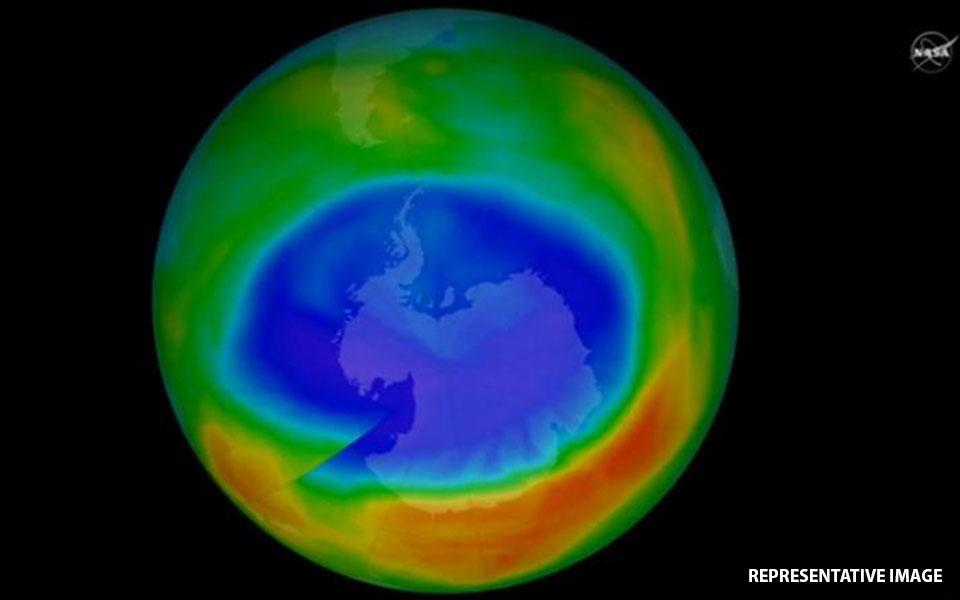Washington, May 17: Emissions of one of the chemicals that can cause hole in the ozone layer are on the rise, despite an international treaty that required an end to its production in 2010, a new study says.
What is even more troubling is that scientists are not sure at present why emissions of this gas are increasing.
This gas, Trichlorofluoromethane, or CFC-11, is a member of the family of chemicals most responsible for the giant hole in the ozone layer that forms over Antarctica each September.
Once widely used as a foaming agent, production of CFC-11 was phased out by the Montreal Protocol in 2010.
The new study, published in the journal Nature, documents an unexpected increase in emissions of this gas, likely from new, unreported production.
"We're raising a flag to the global community to say, 'This is what's going on, and it is taking us away from timely recovery from ozone depletion,'" said lead author of the paper Stephen Montzka, a scientist at National Oceanic and Atmospheric Administration (NOAA) in the US.
"Further work is needed to figure out exactly why emissions of CFC-11 are increasing and if something can be done about it soon," Montzka said.
For the study, scientists at NOAA and Cooperative Institute for Research in Environmental Sciences at University of Colorado, Boulder, in the US made precise measurements of global atmospheric concentrations of CFC-11.
The results showed that CFC-11 concentrations declined at an accelerating rate prior to 2002 as expected.
Then, surprisingly, the rate of decline hardly changed over the decade that followed. Even more unexpected was that the rate of decline slowed by 50 percent after 2012.
After considering a number of possible causes, Montzka and his colleagues concluded that CFC emissions must have increased after 2012.
This conclusion was confirmed by other changes recorded in NOAA's measurements during the same period, such as a widening difference between CFC-11 concentrations in the northern and southern hemispheres -- evidence that the new source was somewhere north of the equator.
Measurements from Hawaii indicate the sources of the increasing emissions are likely in eastern Asia, the study said.
More work will be needed to narrow down the locations of these new emissions, Montzka said.
Let the Truth be known. If you read VB and like VB, please be a VB Supporter and Help us deliver the Truth to one and all.
Mangaluru: Congress leader and former minister B Ramanath Rai slammed BJP leader R Ashoka for calling AICC General Secretary KC Venugopal an agent of the party high command, and asked if the general secretary and other office-bearers in the BJP were commission agents too.
Rai, who addressed a press meet at the Congress office in the city on Friday, expressed fury over the recent comments of the BJP leader that Chief Minister Siddaramaiah was presenting himself in a shameless manner in public life. Ashoka, who is also Leader of the Opposition (LoP) in the Karnataka Legislative Assembly, had said that the Congress government had ‘broken every previous record on corruption-related controversies’.
“Ashoka has spoken with sheer ignorance and displays his lack of maturity, as he often does while facing the media. KC Venugopal has been working at organization of the party and it is unbecoming of Ashoka to criticize Venugopal as he did,” Rai told reporters.
“Being in a responsible position, how acceptable is it for Ashoka to pass disrespectful, random comments about another leader who also holds a responsible position? If KC Venugopal is indeed an agent of the party high command, what should we consider BJP leaders to be? Are they brokers?” he asked
Commenting on Ashoka’s allegations of corruption in the Congress government in Karnataka, Rai pointed out, “The KSRTC land was sold to private parties when he (Ashoka) was transport minister. We can find several such cases across the state, which need to be probed.”
The former minister, however, refused to comment on the incident that occurred at Mangaluru airport during CM Siddaramaiah’s visit to the city recently.
Former mayors Ashraf and Shashidhar Hegde, Congress activists Vishwas Kumar Das, Subhodaya Alva, Shabeer, Baby Kundar, Padmanabha, Nazeer Bajal and Prem were present.





